
http://www.iaeme.com/IJMET/index.asp 793 editor@iaeme.com
International Journal of Mechanical Engineering and Technology (IJMET)
Volume 10, Issue 03, March 2019, pp. 793–807, Article ID: IJMET_10_03_083
Available online at http://www.iaeme.com/ijmet/issues.asp?JType=IJMET&VType=10&IType=3
ISSN Print: 0976-6340 and ISSN Online: 0976-6359
© IAEME Publication Scopus Indexed
LOYALTY PROGRAM DIMENSION AND
FUTURE TREND FOR HOSPITALITY AND
TRAVEL INDUSTRY: A SYSTEMATIC
LITERATURE REVIEW
Dyah Wahyu Sukmaningsih
Computer Science Department, BINUS Graduate Program, Doctor of Computer Science.
Information Systems Department, School of Information Systems.
Bina Nusantara University,Jakarta, Indonesia 11480
Meyliana
Information Systems Department,
Bina Nusantara University, School of Information Systems,
Jakarta, Indonesia 11480
Harjanto Prabowo
Management Departemen, BINUS Business School Undergraduate Program
Bina Nusantara University Jakarta, Indonesia 11480
Achmad Nizar Hidayanto
Faculty of Computer Science,
Universitas Indonesia, Depok 16424, Indonesia
ABSTRACT
Loyalty program(LP) has long become one of the marketing strategies used by the
firms to retain their customer and gain their loyalty. The objective of this study is to
identify challenge and opportunity in designing LP. Five dimensions associated with
designing loyalty programs such as membership, point structure, benefit,
communication program, and partnership have been identified. This Systematic
review will focus on loyalty programs in hospitality and travel related industry. This
paper reviewed 37 articles to explain the important factor in designing LP.
Furthermore, technology advances also influence the evolution of the LP. The future
direction of LP also identified as a guideline for researcher and practitioner to
understand the LP.
Key words: Loyalty programs, Travel industry, Hospitality industry

Loyalty Program Dimension and Future Trend for Hospitality and Travel Industry: A Systematic
Literature Review
http://www.iaeme.com/IJMET/index.asp 794 editor@iaeme.com
Cite this Article: Dyah Wahyu Sukmaningsih, Meyliana, Harjanto Prabowo,
Harjanto Prabowo, Loyalty Program Dimension and Future Trend for Hospitality and
Travel Industry: A Systematic Literature Review, International Journal of Mechanical
Engineering and Technology 10(3), 2019, pp. 793–807.
http://www.iaeme.com/IJMET/issues.asp?JType=IJMET&VType=10&IType=3
1. INTRODUCTION
As an important component of firms' customer relationship management (CRM) strategy
Loyalty programs is firm activities that aim to increase customer loyalty by rewarding
customers for doing business with the firm. The best know loyalty programs in 1981 when
American Airlines launched the first Loyalty Programs (LP). Thereafter, the LP program has
grown and is now reaching various industries, including retail, travel, and finance. Most
major airlines now offer frequent flyer programs, This gives the customer points in the form
of redeemable mileage for free tickets. Hotel and retail also offer LP that encourage customers
to earns points that are redeemable to a prize, discount and other rewards [1]. Through this
LP, companies can receive more repeat business while collecting consumer data that can be
analyzed for targeted marketing activities [2].
LP could increase customer retention and a major advantage in retaining your customers is
that the profits generated by them tend to accelerate over time. Many party support LP
because of cost for customer acquisition is more than customer retention [3]. Loyalty
programs, which often have relationship building, typically including reward cards, gifts,
tiered service levels, customer support, and other methods that can positively influence
consumer attitudes and behaviors towards the brand or business.
In the past 5 years loyalty program literature provided, some exploring in specific industry
that quite popular LP is found, De Boer [4] explore about LP in airlines industry, Tandford [5]
explore the trends in hotel LP, Xie [1] and Dorotic et.al [6] research about future research LP
in general. Nevertheless, LP has also evolved as a consequence of the influence of
technological advancements. New strategy and business model has emerged and implemented
by firms. The purposes of this study are to understand the recent and emerging trend of LP
research.
This literature reviews features of loyalty program studies published in major journals and
synthesize them according to Loyalty Program dimensions. With the focus on the hospitality
industry (hotel, Food&beverage and travel related industry (airlines, MVLP). Finally, this
paper identifies the challenge and opportunity in five dimensions of LP ( benefit, point
structure, membership, partnership, and communication) and organize this the paper
accordingly. Insight about the future trend in LP also provided.
2. THEORETICAL FOUNDATION
2.1. Loyalty Program Definition
"Loyalty programs" are defined as programs created by companies that allow consumers to
collect redeemable points when they make repeated purchases with the company. This kind of
programs rarely benefit consumers in one purchase but are intended for consumers to return to
doing business with the company, so that over time it can foster customer loyalty. Except for
promotions such as instant cards, the promotion is not considered a loyalty program here [7].
According to Oliver [8], customer loyalty is “a deeply held commitment to rebuy or re-
patronize a preferred product/service consistently in the future, thereby causing repetitive
same-brand or same-brand set purchasing, despite situational influences and marketing efforts

Dyah Wahyu Sukmaningsih, Meyliana, Harjanto Prabowo, Harjanto Prabowo
http://www.iaeme.com/IJMET/index.asp 795 editor@iaeme.com
having the potential to cause switching behavior”. Customer loyalty follows four attitudinal
phases: cognitive, affective, conative (behavioral intention), action.
Most recent study, focus on attitudinal and behavioral loyalty [9] [10] [11] [12] [13].
Researchers often measure behavioral loyalty with the two most commonly used indicators:
the intention to patronize the store/business in the future and/or visit more frequently, and
word-of-mouth (WOM), meaning the intention to say positive things about the business and
recommend it to others [9]. Behavioral loyalty can occur without attitudinal loyalty, [14] refer
to as “spurious loyalty”. Consumers visit a firm to buy a good or service because there is no
other option, but without attachment to the firm. If there is the possibility of moving to
another firm, consumers will move easily.
Attitudinal loyalty results from psychological relationships with products or services,
which involve preferences and components such as positive attitudes and commitments that
are based largely on positive beliefs about the brand (Liu-Thompkins and Tam, 2013).
Therefore the researcher measures customer loyalty utilize two-dimensional factor, attitudinal
factor as loyalty commitment and behavioral as buying retention and Word-of-Mouth
(WOM).
2.2. Loyalty program Dimensions
Loyalty program design classified into several dimensions such as (1)
membership/participants requirement (eg. Open versus selective membership, free versus paid
membership) , (2) benefit structure (utilitarian, hedonic and social benefit), (3)reward/point
structure (eg. Timeframe, frequency) [15]. Recently [6] proposed two more dimensions,
program communication, and partnership (fig 1).
Whereas from the customers perspective, loyalty program offers some dimensions
regarding rewards benefit. These benefits induce customer perceived value, thereby create
motivations that induce loyalty program usage. There is plentiful research study about loyalty
programs benefit has to offer to customers. Utilitarian benefit that consists three items;
economic that likely to be monetary is such as discount, free items or redeemable gift;
functional which reflect the emphasis of functionality ( facilitate purchase, fast service); and
informational benefit correspond with greater access to information [16], Other than
economic benefit, Wang [17] and Chiu [16] specify emotional (hedonic) benefits and
symbolic/social benefit, the hedonic benefits tend to be irrational and are based on personal
emotions, occur during the process of purchasing and arise from the playfulness, fun, and
entertainment during the process or participating in loyalty program [18]. Symbolic/social
benefit refers to self-expression, social identity/status, explicit self-esteem, and non-product
benefits for example membership tier that belong to a group of privileged customer.
Membership requirement also has some structure: open versus selective, where open
means loyalty program is available open for everyone, while selective program where
companies invite customers to join loyalty program (eg. Priority banking). Selective
membership can lead to customer gratitude toward firms and depend on the type of
businesses, selective lead to higher loyalty intention toward firm [19]. Joining to loyalty
program also could be free or paid, amazon prime is one of a successful example of paid
membership. E-commerce site also adopts loyalty program, and it has an advantage for recruit
member, every customer who signs up for e-commerce site automatically become a member
of the loyalty program, that different from another firm that still has to attract consumers to
become members of their LP.
Point structure is the mechanism of the company in giving rewards to customers. Yi, Jeon
[20] categorize reward scheme by timing and reward schedule. Timing as in
immediate/segregated and delayed/aggregated, and reward schedule as certain and uncertain.

Loyalty Program Dimension and Future Trend for Hospitality and Travel Industry: A Systematic
Literature Review
http://www.iaeme.com/IJMET/index.asp 796 editor@iaeme.com
For instance, instant-uncertain reward is instant scratch and delayed-certain reward is frequent
flyer stamp or token. The non-linear reward is when consumers get a reward after collect
accumulated points as determined by the firm, for example, store stamp or punch card which
customer can redeem after achieving certain points. Whereas linear reward, points can be
redeemed at any time for any amount.
Firm utilize program communication to provide the latest information about LP using
omnichannel communication such as website, social media, email, and instant messaging.
Social media become more important with the role e-WOM (word-of-mouth),
Communication also corresponds with how firms deliver feedback about the status of
customer reward point.
Partnership loyalty program designates for loyalty program where multiple firms forming
LP and members can earn points from many firms and redeem rewards from the participating
firm. Some literature refers to such program as multi-vendor loyalty program (MVLP). There
is two type of MVLP, first when one company is a major brand in LP (eg. Frequent flyer
card) and second is loyalty card where no firm become dominant, usually this type of LP is
operated by firms specializing in loyalty program management (eg. Plus! in Singapore).
These dimensions elucidate elements for loyalty program design with the purposes to
attract customer usage in LP and subsequently motivate users to become loyal to firms. Fig 1
describes the five dimensions and their sub-dimension which later become the basis of the
organization of this research paper.
Figure 1 Loyalty Program Dimensions
3. RESEARCH METHOD
This paper focused on finding related study in loyalty program design, and from previous
study and exploration, designing of loyalty program concern with five dimensions
(membership, benefit, point structure, communication, and partnership). This study conducts
a review on hospitality and travel industry ( hotel, airlines, restaurants/café)
As much as possible, this paper not discussing particular benefit of LP to the firm. Design
of the loyalty program has goal to attract customer to become loyal to the firm. Nevertheless,
it is possible that some articles missed unintentionally.
This paper restricted to search articles published between 2013 and 2018. For this
literature review, there are five-step :
1. a search was conducted in the content and abstract in SCOPUS journal in the
following databases :
1. Wiley online library (https://onlinelibrary.wiley.com/)
2. Emerald insight (https://www.emeraldinsight.com/)

Dyah Wahyu Sukmaningsih, Meyliana, Harjanto Prabowo, Harjanto Prabowo
http://www.iaeme.com/IJMET/index.asp 797 editor@iaeme.com
3. Springer (https://link.springer.com/)
4. Science Direct (https://www.sciencedirect.com/)
5. Sage hub (https://journals.sagepub.com/)
6. Proquest ( https://www.proquest.com/)
7. AMA (https://www.ama.org/Pages/default.aspx)
8. Taylor Francis online (https://www.tandfonline.com/)
9. AISEL library (https://aisel.aisnet.org/)
2. A search in the content use this keyword: "loyalty programs" AND ("card" OR
"technology" OR “reward” OR “points” OR “rewards”) and “loyalty program” in the
abstract. There is some exclusion, in the Springer database, they don’t provide abstract
search. Hence there is extensive result in Springer database. This search from 9
databases found 564 articles.
3. The articles found were then screened for articles that not research paper. The title of
the article then analyze and exclude for not-related topic, the result was 163 articles.
4. The citation information then downloaded in BibTeX format and copied to Mendeley
software, the article then analyzed to select articles whose abstract related to loyalty
programs dimension and trends mentions in the literature review.
5. From the previous filtering, 94 articles are found and read thoroughly to evaluate the
content. Articles that not related in loyalty programs dimension and travel/hospitality
industry has omitted.
6. Finally, 37 articles were obtained and then classified into loyalty program dimensions.
Table 1 and fig 2 Summarize of our finding.
Figure 2 Diagram representing stages in the literature review
Table 1 summarize papers in search stages
Sources
Found
Candidate
(title)
Candidate
(abstract)
Selected
Wiley online library
34
11
6
2
Emerald insight
51
33
20
6
Springer
294
38
18
7
Science direct
75
34
22
13
Sage pubs
25
20
13
5
Proquest
26
13
3
0
Taylor francis
45
10
8
3
AISEL
108
3
3
1
TOTAL
564
163
94
37
4. RESULTS AND DISCUSSIONS


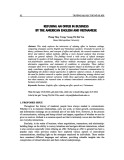
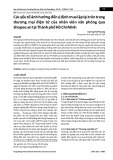
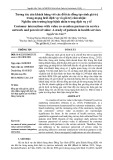
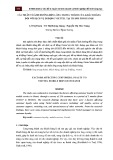
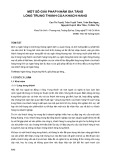
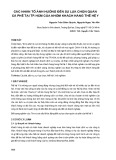


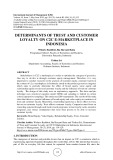


![Đề thi kết thúc học phần môn Truyền thông trong kinh doanh [năm học mới nhất]](https://cdn.tailieu.vn/images/document/thumbnail/2025/20251015/dilysstran/135x160/93281760499390.jpg)


![Bài tập nhóm truyền thông marketing tích hợp [mới nhất]](https://cdn.tailieu.vn/images/document/thumbnail/2025/20250904/hakanami1502@gmail.com/135x160/90671756969236.jpg)


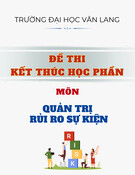


![Định vị doanh nghiệp: Bài thuyết trình [Mới nhất]](https://cdn.tailieu.vn/images/document/thumbnail/2025/20250813/vuthuhuyen1407/135x160/6261755072381.jpg)



